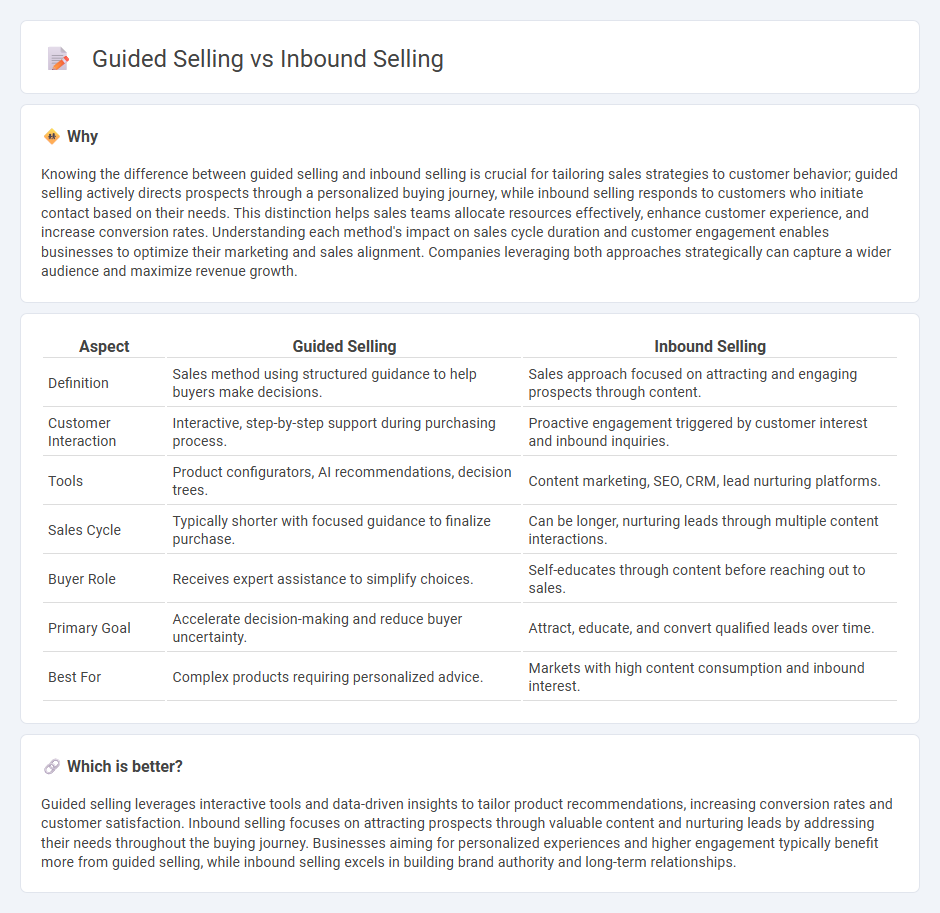
Guided selling leverages interactive tools and tailored recommendations to lead prospects through the buying journey, enhancing decision-making efficiency. Inbound selling focuses on attracting and nurturing leads through valuable content and personalized engagement, aligning with the buyer's research process. Explore more to understand how these strategies can transform your sales performance.
Why it is important
Knowing the difference between guided selling and inbound selling is crucial for tailoring sales strategies to customer behavior; guided selling actively directs prospects through a personalized buying journey, while inbound selling responds to customers who initiate contact based on their needs. This distinction helps sales teams allocate resources effectively, enhance customer experience, and increase conversion rates. Understanding each method's impact on sales cycle duration and customer engagement enables businesses to optimize their marketing and sales alignment. Companies leveraging both approaches strategically can capture a wider audience and maximize revenue growth.
Comparison Table
| Aspect | Guided Selling | Inbound Selling |
|---|---|---|
| Definition | Sales method using structured guidance to help buyers make decisions. | Sales approach focused on attracting and engaging prospects through content. |
| Customer Interaction | Interactive, step-by-step support during purchasing process. | Proactive engagement triggered by customer interest and inbound inquiries. |
| Tools | Product configurators, AI recommendations, decision trees. | Content marketing, SEO, CRM, lead nurturing platforms. |
| Sales Cycle | Typically shorter with focused guidance to finalize purchase. | Can be longer, nurturing leads through multiple content interactions. |
| Buyer Role | Receives expert assistance to simplify choices. | Self-educates through content before reaching out to sales. |
| Primary Goal | Accelerate decision-making and reduce buyer uncertainty. | Attract, educate, and convert qualified leads over time. |
| Best For | Complex products requiring personalized advice. | Markets with high content consumption and inbound interest. |
Which is better?
Guided selling leverages interactive tools and data-driven insights to tailor product recommendations, increasing conversion rates and customer satisfaction. Inbound selling focuses on attracting prospects through valuable content and nurturing leads by addressing their needs throughout the buying journey. Businesses aiming for personalized experiences and higher engagement typically benefit more from guided selling, while inbound selling excels in building brand authority and long-term relationships.
Connection
Guided selling leverages data-driven insights and interactive tools to help prospects navigate complex buying decisions, aligning with inbound selling strategies that attract and engage qualified leads through valuable content and personalized experiences. Both methodologies focus on understanding customer needs and behaviors to provide tailored recommendations that accelerate the sales funnel and increase conversion rates. Integrating guided selling within inbound sales processes enhances lead qualification and drives more efficient, customer-centric sales outcomes.
Key Terms
Inbound selling:
Inbound selling leverages inbound marketing strategies to attract and engage prospects by addressing their needs and pain points through relevant content and personalized interactions. This approach emphasizes building trust and nurturing relationships throughout the buyer's journey, resulting in higher conversion rates and customer satisfaction. Discover how inbound selling can transform your sales process and drive sustainable growth.
Lead nurturing
Inbound selling leverages content marketing and personalized communication to attract and nurture leads, emphasizing understanding buyer intent and providing relevant information throughout their journey. Guided selling uses AI-driven tools and interactive product recommendations to steer prospects toward solutions that fit their specific needs, enhancing engagement and conversion rates. Explore how combining inbound and guided selling strategies can optimize lead nurturing and boost sales effectiveness.
Content marketing
Inbound selling leverages targeted content marketing to attract and engage potential buyers by addressing their specific needs and pain points throughout the buyer's journey. Guided selling enhances this approach by using interactive content and data-driven recommendations to steer prospects towards the most suitable products or solutions. Explore the differences and benefits of inbound and guided selling to optimize your content marketing strategy.
Source and External Links
What is Inbound Sales? Methodology, Strategies & More - Inbound selling is a modern, personalized sales framework that focuses on addressing customer needs and pain points throughout the buyer's journey stages: awareness, consideration, and decision, enabling reps to nurture leads rather than push sales aggressively.
Inbound Sales: Definition, Processes, Best Practices - Inbound sales is a methodology where qualified leads self-select through valuable content, allowing sales reps to engage prospects further along the buying process and build trust by sharing insights and relevant material, making it more efficient than traditional outbound sales.
Inbound Selling: How to Meet Buyers Where They Are - Inbound selling is a customer-focused approach that attracts, engages, and guides buyers by building trust and providing helpful information rather than pushing products, supported by AI tools like Docket AI to improve efficiency and effectiveness.
 dowidth.com
dowidth.com